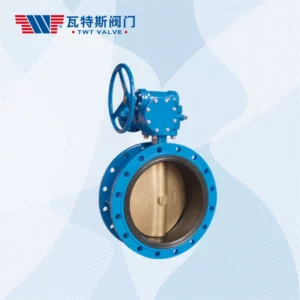A double offset butterfly valve is a type of quarter-turn valve that is used for controlling the flow of liquids and gases. It consists of a disc that rotates around a shaft (stem) in the center of the valve body. The disc is offset from the stem, double offset butterfly valve which creates two separate sealing points along the circumference of the disc. This design provides a tight seal and reduces the wear and tear on the seat, as well as reducing the torque required to operate the valve.
When the valve is in the open position, fluid or gas can flow through the body of the valve and around the disc. When the valve is closed, the disc rotates to a position where it covers the flow opening, creating a tight seal along the circumference of the disc.
What are the advantages of using a double offset butterfly valve?
There are several advantages to using a double offset butterfly valve:
Lower torque: The double offset design reduces the amount of torque required to operate the valve, making it easier to open and close.
Better sealing: The double offset design provides a tight seal along the circumference of the disc, reducing the likelihood of leaks and improving the valve’s ability to regulate flow.
Improved durability: The double offset design reduces wear and tear on the seat, improving the valve’s overall durability and lifespan.
Easy to install: Double offset butterfly valves are relatively simple and lightweight, making them easy to install in a variety of applications.
What are the applications of double offset butterfly valves?
Double offset butterfly valves are commonly used in a wide range of applications, including:
Water treatment: The valves are used to control the flow of water in treatment plants, as well as in pipelines and distribution systems.
Petroleum and gas: The valves are used in oil and gas pipelines, as well as in refining and processing plants.
Chemical processing: The valves are used in chemical plants and refineries to control the flow of chemicals.
Power generation: The valves are used in power plants to control the flow of steam, water, and other fluids.
What are the factors to consider when choosing a double offset butterfly valve?
When choosing a double offset butterfly valve, there are several factors to consider, including:
Media type: The type of fluid or gas that will be flowing through the valve should be considered when choosing a valve, as different materials are required for different media.
Operating temperature: The maximum and minimum operating temperatures should be considered when choosing a valve, as some materials are not suitable for use in high-temperature applications.
Pressure rating: The pressure rating of the valve should be considered to ensure that it is suitable for the specific application and can handle the pressure of the fluid or gas.
Connection type: The type of connection that is required for the valve should be considered, as different connection types are available, including fanged, threaded, and wafer connections.
Actuation: The type of actuation that will be used to operate the valve should be considered, as different actuation options are available, including manual, pneumatic, and electric.
